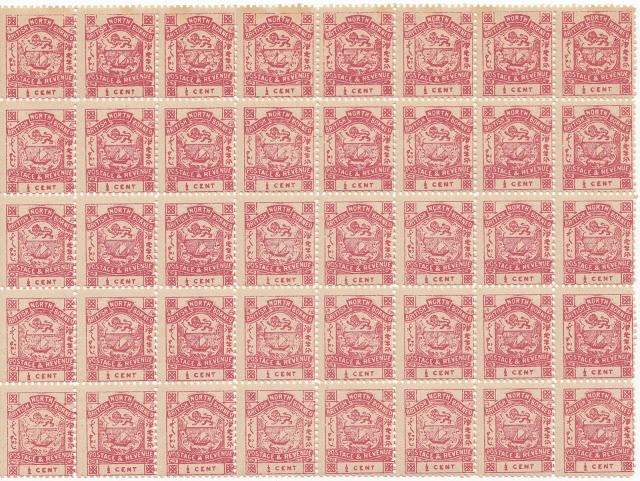The half cent stamp was issued in 1889. It comes in the two shades of magenta and rose. There were 5 different transfers, each with a slight variation in colour but only two shades are listed in the SG catalogue. I am often puzzled by the issue of the half cent stamp as it was not related to any ongoing postal rate and also unlikely any revenue rate either.


These are the two shades of colour. There are quite a few constant flaws to look out for in the authentic half cent stamp. For practical purposes and to make things simple it is better to concentrate on the easy points. The real stamp lacks the extra stroke between the first and second horizontal strokes of the first Chinese character on the right hand side. In addition the other easy to notice constant feature is the coloured dot on the right side of 2 in 1/2 cent.
This is the CTO imperf pair in rose and clearly shows the coloured dot next to 2 and lacking the extra stroke in the Chinese character.

Both of these are very good fakes. The left item shows the extra stroke clearly and also lacks the coloured dot next to 2. The other very important feature is the smaller and raised c in CENT. The right stamp is the corrected version without the extra stroke in the first Chinese character. It is an uncommon forgery but it still lacks the coloured dot and also has the abnormal looking c in CENT. There is also a slight curve in the second and third horizontal strokes of the first character in the forgery. So with these features alone, one can confidently pick out the forgery and the normal stamp. The corrected forged stamp is worth looking out for.
This pair compares the original half cent stamp with the corrected Fournier on the right with the coloured dot next to 2 missing and the slightly raised C in CENT. The perforations are well matched but the paper that these half cent forgeries were printed on has a dull brownish tinge. On the forgery there is also a very well executed bar cancellation. You can click on this image for a closeup and look for the other subtle differences especially with the Chinese characters on the right side. Please also note that the scroll containing POSTAGE & REVENUE touches the outer frame on both sides and there is noticeable gap on the left side with the forgeries.
These three are all forgeries together with fake cancellations. The last stamp has bars that are almost the same as the 14 bar cancel used at Sandakan. I have reasons to think that the stamp in the middle is a Carame and the other two from Fournier. The Carame has a better printed quality and also the presence of the fake Labuan bars (Selsor, Sarawak Specialist Society). The last stamp on the right has the shade in rose but that is probably because it was over soaked and faded. Magenta is the norm for the Fournier half cent forgeries.
This is mainly to show that there is a slight variation in height in stamps of this issue. The half cent stamp is the tallest stamp of the group and probably that it was printed at a different time than most of the group. The 6c is the shortest and was the last to be issued in 1892.
A part sheet of 40 of the half cent forgery of the crude set. The printing is not precise and was said to be in sheets of 100. Multiples of the crude multiperf stamps are more uncommon than those from Fournier. But it is rather strange that the extra stroke in the first Chinese character is also present here. Curiously, it would seem that this value in particular was copied from the Founier/Careme forgeries.
Update 12/10/2016
I bought this full sheet of the Carame half cent forgery. The difference with Fournier is not very apparent to me. I was told about the quality of printing, the more accurate colour and the evenness of the whole sheet and perforations etc but nothing easy to understand and used in practice. There may be further updates as I study this sheet carefully.
A part sheet of 40 of the half cent forgery of the crude set. The printing is not precise and was said to be in sheets of 100. Multiples of the crude multiperf stamps are more uncommon than those from Fournier. But it is rather strange that the extra stroke in the first Chinese character is also present here. Curiously, it would seem that this value in particular was copied from the Founier/Careme forgeries.
Update 12/10/2016
I bought this full sheet of the Carame half cent forgery. The difference with Fournier is not very apparent to me. I was told about the quality of printing, the more accurate colour and the evenness of the whole sheet and perforations etc but nothing easy to understand and used in practice. There may be further updates as I study this sheet carefully.









No comments:
Post a Comment